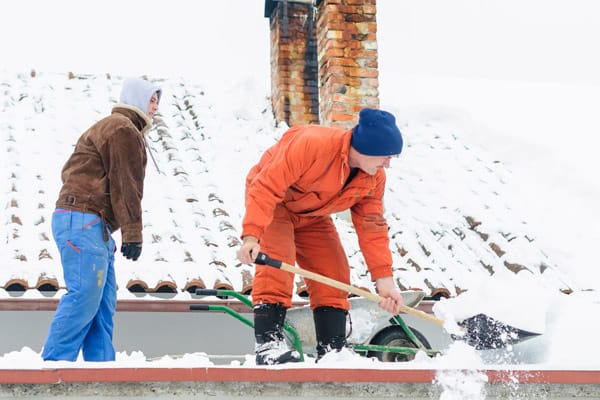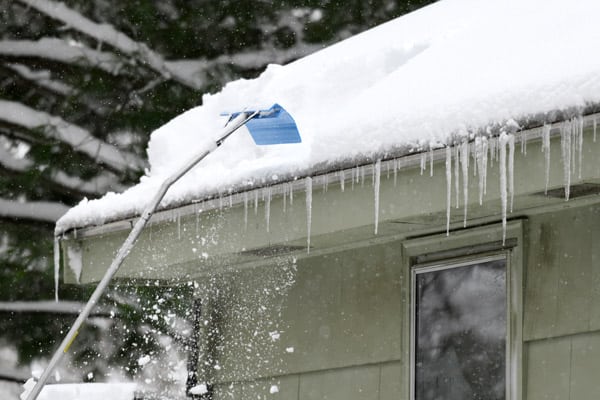How to Properly De-Ice Your Roof
It’s that time of year again—the time to break out the salt and shovels for the porch and driveway, the heavy coats to brave the cold, and the snow blower for when the weather gets really serious.
You’ve got the tools, equipment, and the plans to clear off all of the snow to make winter a little bit easier, but there’s one last part…the roof. With the snow and ice, how are you supposed to properly clear it off and de-ice it?

Snow Rake
A snow rake is a special tool used to remove snow off of your roof. It’s slightly different than a regular rake. It’s long-handled and made of lightweight aluminum (and some will have wheels to make for an easier motion of raking) so you can lift the tool up easily over the roof to rake off the collected snow while you remain safely on the ground. You can find snow rakes at your local home improvement store or online.
Removing the snow off of your roof will improve the heating efficiency of your house. Nearly right away your roof will have improved temperatures once the snow is raked off. Snow rakes are an important tool to have during the winter to prevent ice dams from forming. Using this tool will also prevent damage to your shingles.
By removing snow, you’ll prevent ice formation. When snow melts off the side of your roof like along the gutters, it can freeze and form dangerous icicles. This clogs the gutters and can damage them and the surrounding shingles. It’s best to quickly remove heavy snow from your roof before this occurs. You’ll protect the roof, its shingles, and the gutter system, not to mention improve your home’s overall energy efficiency.

De-Icing Products
If your roof is experiencing more-than-normal ice this winter, you can look into using de-icing products. These are chemicals specially designed to melt ice, but make sure you choose a product that’s appropriate for roofs. Don’t go for cheap de-icing products because they can be highly corrosive and damage the roof as well as surrounding landscaping. Avoid chemicals like sodium chloride and calcium chloride.
Warm Water
This method should only be done in milder temperatures, but nevertheless, it is effective in removing the ice from your roof. You don’t have to melt all of the ice off of your roof, just enough of it to prevent ice dams from forming and the water can freely flow into the gutters without blocking them.
Cold Air
Ice dams are dangerous and sometimes during the winter, you might notice leaks in your attic because of them. You can get rid of ice dams quickly by grabbing a box fan and placing it in your attic. Aim the box fan at the underside of the roof (or wherever the leak is occurring) and let the fan run. The blast of cold air targets the problem area and can freeze water, stopping the leaks right away. You’ll need to follow this up by using a snow rake to make sure you eliminate the opportunity of ice forming on your roof again.
What Not to Do
Use an Axe or Ice Pick
While you can use an ice pick to get rid of the ice on your roof, it’s really not recommended. Climbing on top of your roof in the winter, especially when it’s icy, is not a good idea. It’s dangerous and you could seriously hurt yourself. Not only that but using an ice pick can damage your shingles if you don’t use it correctly. The same goes for an axe, which can damage your shingles even more than an ice pick.
Climb onto Your Roof
Never climb onto your roof during the winter, and it should go without saying that you should never get onto your roof when it’s icy or snowy. Slippery conditions mean that getting onto your roof is not safe, even if you have someone spotting you. Instead, utilize the methods of de-icing your roof where your feet are planted firmly on the ground.
Permanent Fixes for Preventing Ice Dams
An ounce of prevention can save you from the headaches of having to de-ice your roof and worry about ice dams. Tackle the spots of your roof that are common trouble areas and you can prevent ice dams.
- Ventilation: Make sure you roof has a ridge vent as well as soffit vents, which help circulate the air beneath the roof. Healthy air flow can put a stop to icing and ice dams during the winter.
- Hatch: look to see if your attic hatch or whole-house fan is unsealed. This large opening lets the heat escape. By capping the hatch or weather stripping the whole-house fan, you will not only help prevent icing, but you’ll be encouraging the house to be more energy efficient.
- Insulation: An insulated attic means a better protected roof. When you insulate your attic, you’re helping to keep the heat inside as well as beneath the roof. Ice will have trouble forming when the temperature beneath the roofing system is warmer.
With snow and hail, your roof doesn’t have the longevity to sustain a long life. Your roof undergoes decades of structural damage done by the likes of snow and bad weather in the Midwest. At Feldco, we provide the best asphalt shingles made with a water-proof barrier.





